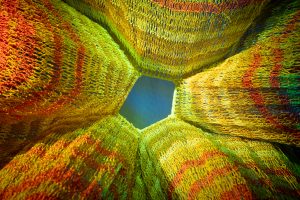In the face of a world crisis, made up of pandemics, slow markets, rising costs of raw materials, a conflict in the Europe’s heart between Ukraine and Russia, perhaps, it is appropriate to reflect on our humanity, also made up of art, in addition to madness, selfies, social media, data and algorithms. If the world is running exponentially towards a constant digitization of the market, of life and of art itself, maybe it is appropriate to ask ourselves some questions, without rhetoric: what is contemporary art for? In its various manifestations, can it tell us what madness is?
Here you will certainly not find a packaged recipe or a precise answer but an indication to follow and learn about the itinerary of the exhibition Crazy, Madness in contemporary art, open to visitors until January the 8th 2023, at the Chiostro del Bramante, in Rome.
Consider these words as objects to be included in your metaphorical shopping bag where, under the “add to cart” key, you can enter this exhibition with twenty-one international artists who have had the audacity and the ardor to tell madness – or what remains of it – from delusional, surprising, performative and theatrical points of view with more than eleven unpublished site-specific installations.
Works conceived to be crossed, indeed inhabited as stated by the curator, Danilo Eccher, who explained that the «concept of madness arises from the fact that everyone lives in the follies of others and when confronted with the follies of others, also expresses their own follies. The challenge is to invite the public to become part of the work and experience the artist’s madness». The curator is recognized for having created very successful exhibitions for the aforementioned Roman institution, such as Love, Enjoy and Dream. Now, with Crazy, the show has really inhabited in an all-encompassing way the external and internal spaces of the Cloister, filling every available room, even those never made accessible.
The exhibition itinerary is articulated starting from the reconstructions of two works by visionary artists of the twentieth century: Ambiente Spaziale, 1968, by Lucio Fontana and Topoestesia, 1965-1970, by Gianni Colombo, that expose elements that trace the loss of meaning, both sensory and optically. From the first artist arises the idea of a minimal and spiritual space, made up of an apparent sensory and perceptive void; while from the second merges an elastic space in a clear optical-perceptive game.
In short, an eccentric and engaging itinerary, which presents also the concrete castings created by the English painter Ian Davenport, and the neon lights by Alfredo Jaar, also visible from the outside of the structure, right next to the Church of Santa Maria della Pace.
The duo Fallen Fruit’s installation also stands out, already presented in Italy during the 2018 edition of the Manifesta biennal organized in Palermo. Again, the vision of the collapse of a ceiling by Thomas Hirschhorn; the illuminations on the floor by Massimo Bartolini; and the hanging gardens and the cosmic glimpses by Petah Coyn.
This way of narrating madness through contemporary art is an attempt to reflect on disorientation, on the lack of balance and on an idea of experiential exhibition that makes the visitors the protagonists and active users of an emblematic insanity that wraps them in the symbolic participatory packaging of the exhibition. Terms already typical of our present time, and that echo the names of the packaging artists Christo and Jean Claude, who had the keenness to see beyond and to tell this somewhat on a macroscopic scale.
In order to answer to the first question, then perhaps it is worth trying the experience of inhabiting Crazy, as it reminds us all of the precariousness of existence, the cancellation of all certainty and that perceptual disorientation, made up of visionary stories, sometimes dizzying. It is always true that both art and madness create dizziness from which to look at the world and ourselves.
Nilla Zaira D’Urso
Info:
Crazy
19/02/2022 – 08/01/2023
Dart – Chiostro del Bramante, Arco della Pace, 5, Roma
www.chiostrodelbramante.it
 Sun Yuan & Peng Yu, Teenager Teenager, 2011, fiberglass sculptures, sofas, variable dimensions, courtesy the artists and Galleria Continua
Sun Yuan & Peng Yu, Teenager Teenager, 2011, fiberglass sculptures, sofas, variable dimensions, courtesy the artists and Galleria Continua
 Janet Echelman, Study for Butterfly Reststop (1/9th scale), 2021, spliced, braided ultra-high molecular-weight polyethylene & nylon fiber, tensioned and draped in combination with architectural structures and projected light, 610 x 350 cm, variable dimensions, courtesy Studio Echelman
Janet Echelman, Study for Butterfly Reststop (1/9th scale), 2021, spliced, braided ultra-high molecular-weight polyethylene & nylon fiber, tensioned and draped in combination with architectural structures and projected light, 610 x 350 cm, variable dimensions, courtesy Studio Echelman
 Fallen Fruit aka David Allen Burns e Austin Young, 2022, Chiostro del Bramante Roma, printed vynil, printed fabric, variable dimensions, courtesy Fallen Fruit aka David Allen Burns e Austin Young
Fallen Fruit aka David Allen Burns e Austin Young, 2022, Chiostro del Bramante Roma, printed vynil, printed fabric, variable dimensions, courtesy Fallen Fruit aka David Allen Burns e Austin Young

Through art she feels the need to get closer to nature, deciding to create an artistic residence on Etna as a “refuge for contemporary art” for artists and scholars. Thus was born Nake artistic residence. She won the Responsible Etna Award 2015. In 2017, she was invited to the Sala Zuccari, Senate of the Republic, as an art critic. She writes for Italian and foreign artists. Curator of the first Museum of Contemporary Art of Etna and of the “Contemporary Etna” project.






NO COMMENT